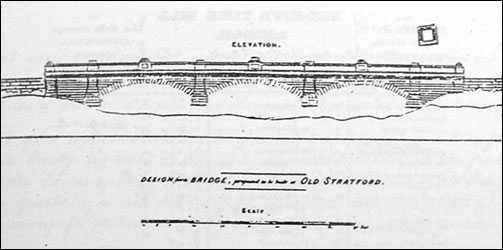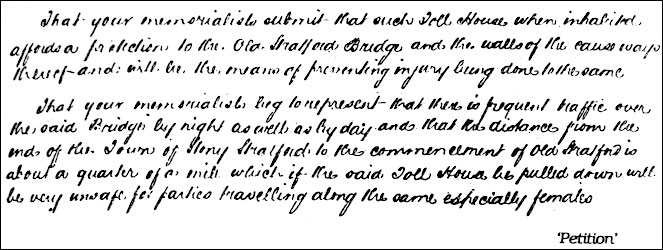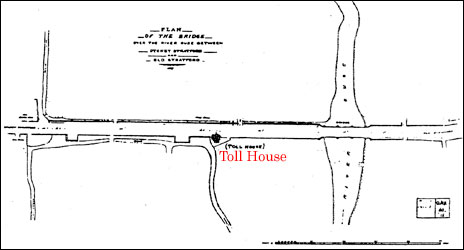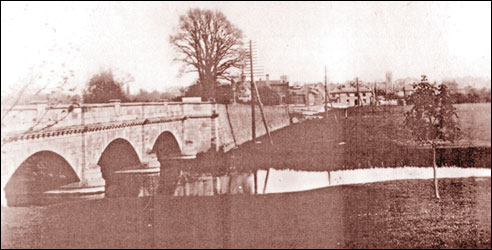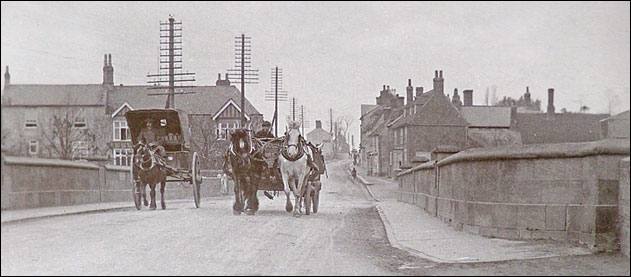 |
|
 |
The Bridge over the River Ouse
Victoria County History Northamptonshire Volume 5 The river crossing from which both Old Stratford and Stony Stratford derive their names must have been replaced by a bridge, first mentioned in the 13th century, at an early date, although in the 1830s Baker claimed that the site of a ford could be identified immediately upstream from the bridge. In the early 17th century the bridge crossed the Ouse itself by a single span, flanked on the Buckinghamshire bank by a causeway pierced by three groups of three arches, apparently built to carry water off the meadowland alongside the river. The bridge is said to have been partly destroyed in the Civil War and then to have become dilapidated. In 1801 an Act for paving, lighting and improving Stony Stratford also provided for the repair of the bridge, whose maintenance had, ,since the early 16th century, been the responsibility of a local charity.This measure was evidently insufficient, and in 1834 the two counties which shared responsibility for the bridge obtained another Act, under which a new bridge was built the following year. The Act provided for the cost of the bridge to be divided between Northamptonshire and Buckinghamshire; for tolls to be collected for 21 years; and for the charity which had previously maintained the old bridge to be discharged from this responsibility. Tolls were apparently taken at the bridge in the Middle Ages.
The Bridge over the River Ouse There are three rivers in England called the “Ouse”. One is situated in the Midlands and eastern England, one in Yorkshire and one in Sussex. The Midland River is often known as the Great Ouse. The Great Ouse separates Old Stratford and Stony Stratford. It also rises in the hills between Banbury in Oxfordshire and Brackley in Northamptonshire. It turns northeast to Stony Stratford in Buckinghamshire and is joined by the smaller rivers the Tove and Ouzel.
The Northampton Mercury January 25th 1800 On Sunday evening, between nine and ten o'clock, as one Baldwin, a shoemaker, of Stony Stratford, was crossing the bridge to Old Stratford, owing to the darkness of the night he slipped off the causeway into the water, and was unfortunately drowned.
In 1815 the Buckingham to Newport Pagnell road became tumpiked and it is apparent that by then the route on the north bank of the Ouse from Old Stratford through Deanshanger was more desirable than the old way to Beachampton, probably because it lay along higher ground which was less liable to flooding. Most of the old cast-iron milestones can still be seen along this road, though the one on the road from Stony Stratford to Wolverton had been re-sited, originally being in the Old Wolverton Road by which the Turnpike went, prior to the development of the new town of Wolverton Station in the mid nineteenth century.
The whole of the London to Holyhead road, Watling Street, had been reconstructed under the supervision of Thomas Telford as a central government project following pressure from the G.P.O. which found it unsafe for its mail coaches. The treasury allocated a large sum to this in 1815 and by the 1830's, when the road was completed, time tables for London to Manchester service show a distance of 196 miles was scheduled to take just over 18 hours on the north-bound journey and nearly 20 hours coming south. This same journey had taken four days or so during the mid 1700's.
In 1833 a team of horse drawn wagons were transporting to Coventry a piece of machinery for making plate glass. The bridge at that time was made of timber, and as the last wagon went over the bridge, the timber weakened and the wagon fell through into the river Ouse. It took forty harnessed horses to drag it up the steep hill to Old Stratford. A Government Act in 1834 allowed the bridge to be rebuilt and the causeway to be raised by 4ft. This rebuilding took one year to complete and it was re-opened to traffic on July 25th 1835. The first stone was laid by the Rev. Loraine Loraine Smith, the rector of Passenham and a local J. P.
The Northampton Mercury February 14th 1835 CONTRACT FOR BUILDING OLD STRATFORD BRIDGE, on the Holyhead Road. NOTICE is hereby given, That any Person desirous of Contracting for building a Stone Bridge over the River Ouse, situate on the Holyhead Road, at or near Stony Stratford in the County of Buckingham, and Old Stratford, in the County of Northampton, is requested to deliver a Tender in writing for the same, sealed up, addressed to THOMAS TINDAL, Esq. Clerk of the Peace for Buckinghamshire, at his Office in Aylesbury: or to CHARLES MARKHAM. Esq. Clerk of the Peace for Northamptonshire at his Office, in Northampton, on or before the 17th day of March next. The Party contracting will be required to give two sufficient sureties for the due performance of his Contract, and is to set forth in Tender the names, and description of such sureties. The Superintending Justice of the Peace for the said Counties of Buckingham and Northampton. appointed in pursuance of the Act of Parliament made and passed to the 4th year of the Reign of his present Majesty, King William the Fourth, intituled "An Act for taking down and removing " Old Stratford Bridge, over the River Ouse in the Counties "of Buckingham and Northampton, and for erecting a more "commodious Bridge in lieu thereof,” will MEET at the COCK INN, in Stony Stratford. On WEDNESDAYT the 18TH day of MARCH next, at Eleven o'clock, in the forenoon, to receive the Tenders, and to decide upon which shall be accepted; but the said Justices do not undertake to accept the lowest Tender, but reserve to themselves the right of fixing upon such as, under all circumstances, they shall deem most eligible. Plans and Specifications of the intended New Bridge, and all particulars required in the Tenders, may be seen at the Office of the Clerk of the Peace for Buckinghamshire, in Aylesbury; and at the Office of the Clerk of the Peace for Northamptonshire, in Northampton. THOS. TINDAL. CHAS MARKHAM. 13th February, 1835.
The bridge has three stone arches and was raised by the aforementioned 4ft to prevent any flooding. The road that crossed the bridge was just enough for two horse drawn carriages to pass one another at the same time. The bridge then, as now, was surrounded by meadows and some beautiful scenery. It was carried across the river on three arches from the higher ground at Old Stratford and continued with a raised causeway across the flood meadow on the Stony Stratford side.
The Northampton Mercury August 1st 1835 On Saturday last, a considerable number of persons assembled to witness the laying of the first stone of Old Stratford New Bridge. It had been proposed that Major Mansel, the oldest magistrate at that time in the neighbourhood, should perform the ceremony ; but being obliged to decline it from infirm health, it was laid by the Rev. Loraine Loraine Smith. A bottle was inserted in the stone in which were deposited various gold, silver, and copper coins of the realm; the Northampton and Times newspapers, and a piece of vellum, bearing the following inscription, written by Mr. John Durham, jun.:—"This bridge was erected under the authority of an act of Parliament passed in the 4th year of the reign of Wm. the Fourth, Anno Domini 1835; the first stone whereof in the presence and under the superintendence of John Christopher Mansell. Esq. and other Justices of the Peace for the counties of Buckingham and Northampton, on Saturday the 25th of July, 1835” digging out the foundation of the old bridge, some ancient copper coins were discovered, with a human skull, a pair of ancient stirrups of curious make ; a spur, measuring 9½ inches from the back of the heel to the extremity of the rowel ; a war-hook, a spear, an instrument forming an adze and hammer, a small earthen urn, and sundry other ancient relics—most or all of which were found from six to ten feet below the bed of the river. After the ceremony of laying the stone was concluded, the workmen, about forty in number, partook of a dinner and plenty of ale, which had been ordered by the magistrates There were ongoing discussions and disagreements regarding the expenses for the Bridge project, mainly due to its crossing parish and County boundaries.
The Northampton Mercury August 29th 1835 Comment: To the Editor of the Northampton Mercury “Another is building at Old Stratford, the extremity of the county designed more to benefit Stony Stratford and the county of Buckingham; yet the expense it appears, is to be paid from the county rates of Northampton - £114. 8s. 5d. having been paid during the past year.”
The Northampton Mercury August 29th 1835 An Abstract of the Account of the Receipts and Expenditure of the Treasurer of the County of Northampton, ending the April sessions, 1835 On account of the New Bridge, at Old Stratford £1,768 2s. 4d.
The Northampton Mercury October 31st 1835 Stony Stratford Bridge was reported to be in forward progress. Mr. Ireson had completed one part of his contract, and the Surveyor stated that the work was extremely well done. It is to be finished by the 1st of September, 1836.
The following articles from 1836 onwards show us how the various authorities attempted to defray the costs of its construction and maintenance via the tolls system. The Northampton Mercury June 18th 1836 OLD STRATFORD BRIDGE In pursuance of the Order of the Superintending Justices appointed under the Act of Parliament passed in the 4th year of the reign of his present Majesty King William the Fourth, intituled “An Act for taking down and removing “Old Stratford Bridge over the River Ouse, in the Counties of “Buckingham and Northampton, and for erecting a more “commodious Bridge in lieu thereof,” made at a Meeting held at the Cock Inn, at Stony Stratford, on Monday the 16th day of May, 1836; Notice is hereby given, That from and after TWELVE O’CLOCK of the night of SUNDAY the THIRD day of JULY next, the following TOLLS will be demanded, taken and received at the TOLL GATE to be erected at the said Bridge, before any Cattle or Carriages shall be permitted to pass through the same (that is to say):
The Northampton Mercury July 30th 1836 An Abstract of the Account of the Receipts and Expenditure of the Treasurer of the County of Northampton, ending the 29th June, 1836. To the several Sums borrowed on Mortgage of the County Rates under the Old Stratford Bridge Act. £2,500.
The Northampton Mercury October 7th 1837 An Abstract of the Account of the Receipts and Expenditure of the Treasurer of the County of Northampton, ending the 26th June, 1837 To Cash received of John F. Congreve, Esq. for the half share of the Fees paid by the County of Northampton to Messrs. Dorington & Co. for Soliciting the Old Stratford Bridge Bill £214 10s 5d On Account of the New Bridge at Old Stratford, viz. J. F. Congreve, Esq. the Treasurer, on Account 1,700 0s 0d interest of money borrowed £100 0s 0d
The Northampton Mercury December 8th 1838 An Abstract of the Account of the Receipts and Expenditure of the Treasurer of the County of Northampton, ending the 30th June, 1838 To a further sum borrowed on Mortgage of the County Rates under the Old Stratford Bridge Act. £1,000 Ten years later, these arguments were still persisting, as the deadline for the abolition of tolls approached, and the Bridge was still not paid for.
The Northampton Mercury October 20th 1849 Stony Stratford Bridge. The Clerk of the Peace reported to the Court that the sum £3,500 would be payable from the county in 1855, borrowed in 1834 for the building of Stony Stratford Bridge. Mr. SAWBRIDGE and the Legislature had contemplated when the act was granted that the tolls would be sufficient to pay interest and principal in 21 years, when the tolls were to be abolished. But the opening of the London and North-Western Railway had had the effect of so reducing the tolls that they did not pay the interest. The question was whether they could not obtain some relief from the Legislature. Mr. WING remarked that as soon as the Buckinghamshire Railway opened, the tolls would fall off still more. On the motion of Colonel CARTWRIGHT the question was referred to the Superintending Justices of Northamptonshire and Buckinghamshire relating to the bridge.
One hundred and fifty years later the Bridge still stands, carrying the huge increase in today’s traffic. The only difference is the absence of the Toll House which originally stood at the southern end. This was removed in 1857 despite a petition by 69 local inhabitants, amongst whom are to be found most of the 'solid citizens' of the time, who expressed concern that this would lead to damage to the bridge and danger to people using it.
|

